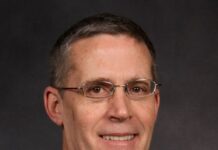
David M. Dooley, the new president at the University of Rhode Island, can’t think of another place where an Ivy League school and a public university have had a partnership like Brown University and URI’s.
On the job for three months, Dooley is looking to ramp up the cooperation.
In a wide-ranging interview, Dooley recently told Providence Business News he’s begun preliminary talks with Brown University President Ruth J. Simmons about allowing students to cross-register for classes. He would also like to collaborate with Brown to possibly develop a research park of sorts in Providence, in addition to one in South Kingstown. That’s a departure from URI’s initial plans to construct one 30-acre park adjacent to the Kingston campus.
PBN: Where do URI’s plans for a research park on campus stand, now that you’ve had a few months to examine the work that had been done before your arrival?
DOOLEY: Well, we had a terrific meeting the other night with the senior leadership of Brown University at Ruth Simmons’ house, and one of the things we talked about is what we might do together in a whole host of areas, including, by the way, joint academic curricula with students going back and forth between the two institutions.
Ruth Simmons was the president of Smith [College] for a number of years; I was at Amherst College as a faculty member. Both of us saw an organization called the Five Colleges Inc., which enabled students to move amongst Amherst, Smith, Mount Holyoke, Hampshire and UMass in a seamless way. It had great benefits for the institutions and the students. We’re both looking at that experience up there – where things were no closer in terms of travel times – and asking whether we couldn’t put together a similar experience for undergraduates between the two institutions. Beyond that, we’re very interested in building on a very good foundation, and we have a lot of momentum. Much tighter research collaborations, much more extensive research collaborations.
In that respect, one of the things we’re thinking about is that the real answer to the research question for URI is probably a multisite solution. That is, we will do something – perhaps in the Jewelry District in partnership with Brown, Johnson & Wales and the hospitals, for instance – where we would colocate with them and put some activities there. And for other kinds of activities and potential partners, the proximity to the Kingston campus may be paramount in terms of what they’re looking for. They may really want to have direct access to the facilities and the faculty and students in the Center for Biotechnology and Life Sciences or the College of Pharmacy building or the new chemistry building, all of which will be clustered there on the north edge of campus.
What we will be looking at over the next few months is revising the work and the analysis that’s been done so far on a research and technology park and looking at it through that lens — developing a much firmer list of potential partners, a much more defined list of potential funding sources. Who’s willing to bring what to the table, whether it’s a commitment to a long-term lease for a particular amount of square footage in a particular location or whether it’s federal assistance? I’ve asked the team – Peter Alfonso, vice president of research, Don DeHayes, the provost, and Bob Weygand, the vice president of administration and finance – to build a business plan that will give us some confidence that, if initiated, it would be successful and there would be good return on investment. We don’t have that at the moment.
PBN: But there were renderings and building plans and price tags to place the park in a wooded area north of the Kingston campus. Now you’re considering multiple sites?
DOOLEY: None of that work will be undone. What was missing from that analysis, however, was viewing it through the lens of the current economic conditions and the likely conditions for the next 24 to 36 months. Who are the partners who will come to the table and fund it? Because we’re not going to put in tuition dollars, and it’s unlikely we’re going to take money out of the state’s general allocation to URI to do it.
What happened, to be candid, is things got a little bit ahead of themselves. And once they had a rendering of a place sitting in a particular location, it engendered all kinds of controversy about that location. The campus got caught up in that and never took the next step.
PBN: Is the site north of campus still under consideration despite there being concern about destroying a forest located there?
DOOLEY: Absolutely. From my perspective, all locations in proximity to the campus are on the table. You really want to find out what your partners want. We have potential partners who might actually prefer us to do a building together with them on the Narragansett Bay campus. … Other potential partners would say, “Oh, you’re going to have something in Providence? I’d rather do that.”
[The idea of multisite research facilities] is an outgrowth of the conversations with the city, with the Providence [Chamber of Commerce] and with Brown, and asking the question: What would be beneficial to URI students and faculty to do in Providence?
PBN: What’s your deadline for these new plans?
DOOLEY: I want to get a plan developed that we can really run with before next summer. We’re got a couple of people on our research foundation who are potential participants and leaders in plan development. In the spring, I intend to bring in an outside group … to review our research enterprise, including intellectual property, policies, technology transfer and have them participate in an assessment of what the R&D park solution might look like.
PBN: What research and development activities would be located where?
DOOLEY: Let’s say we want to do things that have a lot to do with translation of basic science into clinical practice. Well, that might be something you might want to do in collaboration with Brown and Lifespan in a location in Providence, where you could build a critical mass where they don’t feel isolated even though they’re not on the Brown campus or the URI campus. We would have to work through how we would facilitate actually getting back and forth from Kingston to those locations.
Another thing I’m thinking about in Providence – and the business college is pretty excited about the possibility – is if you wanted to build some kind of entrepreneurship center and incubator space, well for some kinds of startup companies, they would want to do that in Providence. For others, they would want to do that looking out at Narragansett Bay or next to the university. It depends on what they need.
Having a space like that in two locations, depending on what they need, actually might be the best solution for Rhode Island in general. We could have one in Providence in partnership with Brown.
Part of the problem [that I see], as a newcomer to Rhode Island, is Rhode Island is doing a lot of things that have the right titles. But they appear to be a little uncoordinated, maybe more than a little in some respects, and fragmented. We need to bring these things together, have many fewer umbrellas out there, and start to benefit from the proximity of the community we can build in a place like Rhode Island.
PBN: URI doesn’t already own property in the Jewelry District of Providence, does it?
DOOLEY: No. We might colocate with properties, for example, that Brown may have. They may want us to colocate with them. The city certainly wants us there. I had a meeting with the mayor [earlier this month].
PBN: What would be the focus of the multiple research sites?
DOOLEY: Certainly biotechnology, life sciences and health. I think the challenges there are large. Even though lots of states and lots of universities have jumped on that, it’s such a huge and enormous playing field that it’s still quite possible for URI to be extremely competitive and carve out a niche for ourselves. And this is an area where collaboration between Brown and URI can pay some enormous dividends. They’re very interested in it.
Energy. Without a doubt the energy challenges ahead of us are dramatic. … That should be an area where we invest a lot of R&D, and I think the Obama administration has signaled that is their intention.
Information technology, communications. I think global communications has never been more important.
PBN: Let’s get back to your discussions with Brown University President Ruth Simmons. Both schools are looking to step up their collaboration?
DOOLEY: It may be unique. I don’t know of any other public-Ivy partnership that already has the momentum and foundation that URI-Brown has. Over the past few years, through leveraging federal support between the two institutions, more than $100 million has flowed into the state as a result of that collaboration. What’s more important for the future is, it has built a great relationship between researchers at Brown and URI. It provides a great platform to demonstrate what can happen in Rhode Island if we do take advantage of proximity and community. You take the intellectual capital of two institutions and bring them together, and you’ll get a lot more out of it than if they continued to go their separate ways. That’s the vision that I see, and I think it’s shared by President Simmons. •












